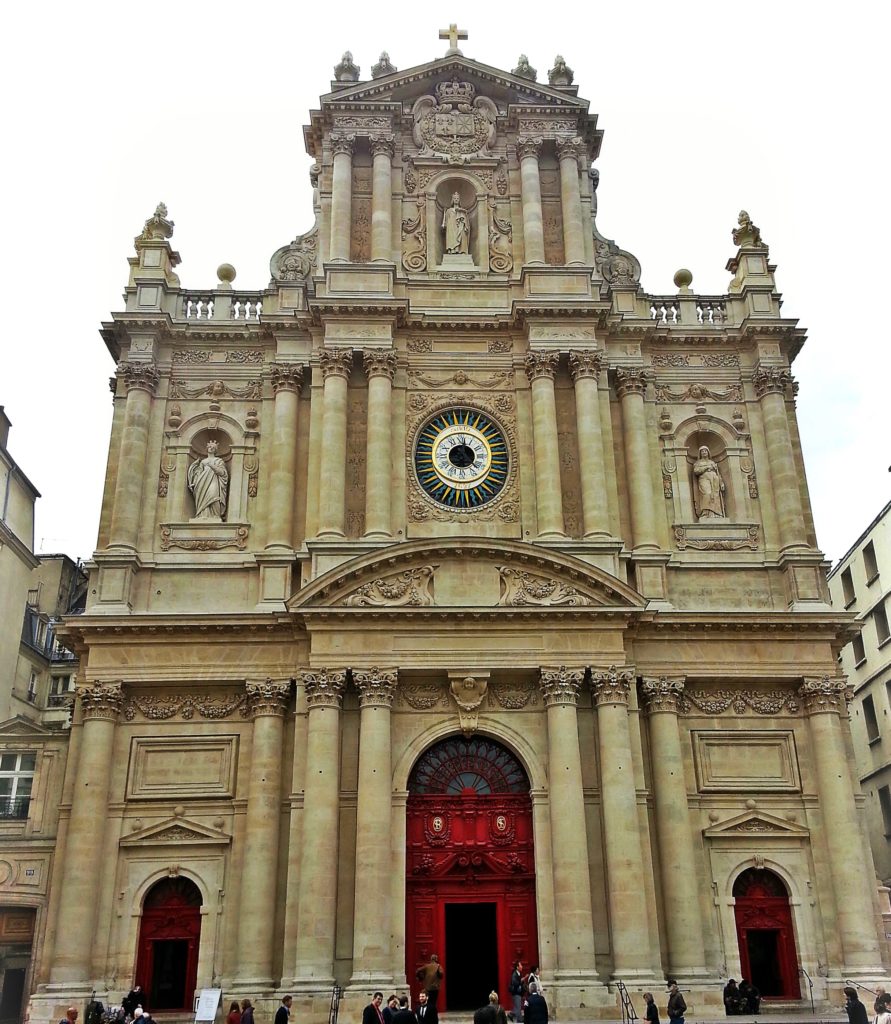Back to Le Marais.
I can’t, at this point, precisely retrace our steps that afternoon and I don’t have many photos to stir my memory. I do remember that we walked up the main boulevard because we were slightly intrigued by its name – the boulevard de SĂ©bastopol. Looking at the map and recalling that we came within sight of the Pompidou Center (a building so antithetical to my aesthetic that I could bring myself to take only a single photo of it) I’ve concluded that we must have walked past Duc des Lombards – the very club where we’d seen the jazz show just more than a week ago – and not realized it. Or perhaps I simply don’t remember realizing it.
My pictures indicate that we somehow roamed far enough astray that we reached the Museum of the National Archives. While we had to walk east from the Boulevard de Sébastopol to reach this particular museum, we had also taken ourselves three-quarters of a kilometer farther north than was necessary.
Eventually we managed to find our way south to rue de Rivoli from which we would learn we had a second entrance to our building. Rue de Rivoli is a broad avenue lined with shops, a few restaurants, and is very convenient for picking up a bit of this or that as you’ll soon see. Before we reached the immediate neighborhood, we encountered small retail stores including a hat shop which I had to enter because…well, hats (and Europe is where I buy most of mine).
(Here’s an important French travel tip. When you enter any shop, it is incumbent upon you to greet the shopkeeper. A pleasant, “Bonjour!” should suffice. Even if you can’t learn to ask, “Pouver vous m’aider en Anglais, s’il vous plaĂ®t?” (Can you help me in English, please?) by merely using the greeting you’ll find you’ve set yourself up for a much more pleasant interaction than if you neglect it. While I didn’t buy a hat, I did have a very cordial and helpful exchange – mostly in English – with the proprietor.)
As we would discover when we reached Saint Paul, within blocks of our building we had a butcher (boucherie), a chocolatier, a cheese shop (fromagerie), a fruit and vegetable specialty shop (verger), more than one bakery (patisserie), and a beer and wine shop that Pat and I patronized where we again received wonderful service and help in English.
The closest MĂ©tro stop to our building was Saint-Paul – so named because of the nearby church.
It’s formally the Paroisse Saint-Paul-Saint-Louis and when we walked past on Thursday we saw a sign that would give us something to do Saturday night.
The cheery cherry bistro.
We returned to the flat with our beers and while Pat started a small load of laundry, I uploaded and tagged the pictures I’d taken and began scanning Fork – the French equivalent of Yelp! – for a place to have dinner. We opted for Le Temps des Cerises. A short 400-meter walk from our front door, this bistro sits on the corner of two wonderfully named streets – rue de la Cerisaie and rue du Petit Musc (Cherry Orchard and Little Musk Streets).
Le Temps des Cerises is also a well-known French song and I have little doubt that the restaurant’s name is intended to evoke both its location and the song. Jean-Baptiste Clement wrote the poem in 1866 and Antoine Renard set it to music two years later. Filled with heartache and deep red imagery the song became something of a revolutionary anthem for the short-lived 1871 Paris Commune. (Connections.) In fact, at least one report says Clement participated in the final battle known as “Bloody Week” and that he subsequently dedicated the song to an ambulance nurse, Louise Michel, also known as “the red virgin of Montmartre.”
The song’s most popular version was probably the one recorded by Yves Montand but I prefer Nana Mouskouri’s interpretation.
We arrived at the tiny bistro at the somewhat inopportune but simultaneously fortunate time of 18:30. Inopportune because the kitchen wouldn’t open for another hour and a half. Fortunate because by the time the kitchen would open we’d barely have had room to breathe – the tables are bare centimeters apart – let alone find a place to sit.
The bar was open so while we waited Pat ordered wine while I, of course had a beer (Kronenbourg 1664) and we nibbled on fresh radishes that we could dip in salt. I had a delicately tasty dorade (sea bream) with a light sauce served on a bed of haricots verts (green beans) with mashed potatoes.
Filled with a mix of visitors and locals, I had the feeling I was eating in an authentic French bistro. As for the meal itself, it was delicious. Certainly, the restaurant’s location – a side street on the edge of the le Marais and la Bastille – and its size would keep it off the radar of the Michelin guide as, perhaps would its down to earth menu. The quality of the meal, however, would I think, earn it some recognition.
Since we’d walked quite a lot through the day, I believed I’d earned dessert but due to my careless reading of the menu, the dessert that arrived wasn’t quite the one I expected. I thought I’d ordered a profiterole and was expecting a frozen whipped cream filled choux pastry beneath a chocolate ganache. What the server brought (and what was on the menu) was cannelĂ©s façon profiterole or fluted way profiterole. This version was a dense caramelized split cake served (as a profiterole sometimes is) with ice cream between the layers and dripping with chocolate ganache. Needless to say, I prevailed upon Patricia to take the long way back to the flat.
In the next post, we’ll meet David Downie for a full day tour beginning in our neighborhood le Marais.
